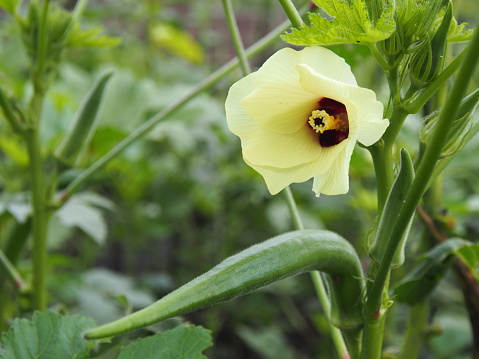Okra is a very unique and not well-known vegetable in the west. In India, it is known as bhindi. It is often dismissed because of its sliminess but when prepared well it is delicious and it is one of the superfoods.
I first enjoyed okra in India where they make so many tasty meals with okra. Recently I enjoyed a vegan okra gumbo in New Orleans where it is popular because it grows well in hot climates.
It also has many amazing health benefits, so let’s check them out.
6 Health Benefits of Okra
1. Top Source of Protein
Okra is a high-quality protein; it has an amino acid composition comparable to soybeans and the protein efficiency ratio is higher than soybeans. It is a top vegetable protein food.
There are other possible okra health benefits such as lowering blood sugar for diabetics and anti-fatigue benefit but they do testing on mice or rats, I will only use research based on using humans.
2. Excellent for Heart Health
It has good soluble fiber which helps reduce cholesterol and also lessens the chance of heart disease. – Journal of Food Processing & Technology
3. Kills Breast Cancer Cells
Lectin isolated from okra was found in a study to kill cancer cells in the breast and the growth of the breast cancer cells was inhibited by 63%.
4. Great for Lowering Cholesterol
Almost half of the pod is soluble fiber, which helps lowers cholesterol according to research. It binds to excess cholesterol and toxins in the bile to be eliminated. Add it to your cholesterol-lowering list.
5. Helps with Gastritis
When there are bacteria in the stomach, inflammation is created causing gastritis. There is an anti-adhesive compound in okra that binds to the surface of the gut blocking the bacteria attaching to the stomach lining. It was found in a study that okra juice prevents this from happening and creating gastritis.
For centuries, Asian medicine has used it to treat gastric irritations. Extensive studies have investigated the helpfulness of it in detail. – National Institutes of Health
6. Great for Memory
It can boost the brain’s cognitive abilities. Studies have shown that extracts reduce the risk of Alzheimer’s disease, protecting against other degenerative neurological diseases.
Please Note
This vegetable is one of the many high-nutrient foods that contain measurable amounts of oxalates. Individuals with known or suspected kidney or gallbladder problems are recommended not to eat these high-oxalate foods. This is a much-disputed subject, however. (See Oxalic Acid Controversy.)
Also, it should not be cooked in copper, brass or iron cooking pans because the metal will be absorbed making them filled with poisons.
Nutrition
It is full of valuable nutrients such as protein, vitamin C, magnesium, vitamin K, and is high in fiber. It even has vitamin A, E and many B vitamins. Learn more about okra nutrition.

Trivia
- Cleopatra loved to eat okra.
- “Seven-days-old fresh okra pods have the highest concentration of nutrients.” – Journal of Food Processing & Technology
- It is a tropical flowering plant native to Africa, close to the hibiscus that can grow up to 6 feet high.
- The Egyptians used the seed pods as a coffee substitute.
Okra History
- It grew wild along the Nile and in Ethiopia.
- It was first grown in Egypt in the 12th century B.C.
- The cultivation spread throughout the Middle East and North Africa.
- Okra came to the U.S. in the 1700s and is thought with West African slaves. Not much later okra came to Western Europe.
- The Creoles in Louisiana learned from slaves how to use okra to thicken soups and now it is an essential ingredient in Gumbo.
- Although it is now very popular in India, it seems it didn’t get there until after the beginning of the Christian Era.
How to Select
Choose bright green pods that are less than 4 inches long and not bruised, soft, or blemished with blackened age spots. When they are too ripe, they have a very sticky texture. In the South, it is available fresh year-round and in other areas from May to October.
How to Store
It is best stored in a paper bag or in a perforated plastic bag in the refrigerator for 2 to 3 days.
To store for a longer time it is best to freeze.
- Carefully trim the stem ends, don’t cut into the pod and then blanch for 3 to 4 minutes.
- Dip them briefly into ice water, and then place them on a parchment paper-lined baking sheet.
- Place in the freezer and when they are frozen, put them into freezer bags.
- Carefully vacuum seal if you can; it’s best not to remove all of the air as it may get crushed.
Tips for eating or cooking:
We often hear unkind comments about okra, because usually, they don’t know how to prepare it.
Best not to wash them until you are using them as they become slimy. The more they are cut, they become very slimy. Also, note that aluminum pots will discolour okra.
It is mostly pan-fried, battered, steamed, or grilled to make soups, sauces, stews or curries. It is a common vegetable in Indian cuisine and a common ingredient in Creole cuisine.
You can even eat it raw in a salad.
It is also used as an egg white substitute or as a fat substitute in chocolate bar recipes and in a frozen dairy dessert.
Here are some of my favorite okra recipes:
Okra Sauteed with Cashews and Garlic – Cashews in this dish adds a crunch and the garlic lends a spicy taste to this tasty meal.
Crispy Okra Is A Wonderful Tasty Vegetable For Your Meal– My favorite way to eat this vegetable, crispy is so yummy with a flavour that is amazing.
Bhindi Masala (Okra with Tomatoes) – This is a very special dish from India.
100+ Superfoods
Learn more about some of the healthiest vegetarian foods you will always want to have in your pantry or growing on your deck.
READ: Superfoods – Over 100 of the Healthiest Foods You Should Have in Your Diet and learn more about the variety of Superfoods we think you should have in your diet.

